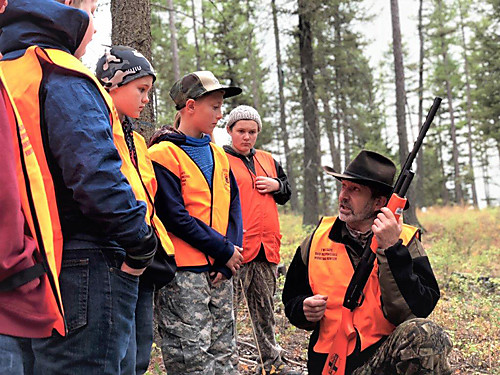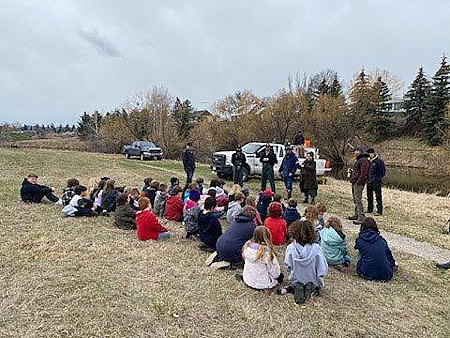Chancy Jeschke of Chancy and Dave’s Fish Camp, presentation, Ice Fishing 101:
Ice Safety you are ”Never too Safe”: Chancy told stories of falling through ice even when drilling holes as he worked his way from shore. Dark spots in ice might be a sign of weak ice, especially if the lake has underground springs.

Safety Equipment:
30 ft Rope with life preserver or a loop at end -used to throw to victim and keeps rescuer (Chancy & Jim) from falling into hole with the victim.
Ice picks attached to string that is worn around neck on outside of coat-used by victim to help pull themselves from the water onto the ice.
Ice Cleats with strap over the boot- used to walk out on slippery ice which prevents falling injuries.
Extra set of clothes kept at vehicle incase you fall through the ice, you can then change from wet to dry.
Hand & Toe warmers- place inside gloves or boots for extra warmth
Good quality Outerwear- prevents hypothermia and frostbite

Technology and Ice Fishing:
Vexilar fish finder – will show water column and fish activity, batteries last longer if recharge often and keep in warm environment. Prices range from $300-$400. Very reliable.
Fish finders -all kinds: Garmin, Hummingbird. Garmin just came out with the “Garmin Live Scope” which shows different perspectives under water, downward, 60 ft in all directions to 120 ft in forward perspective. $3500.Can, also, be set up in a boat.
Augers – Most ice fisherman are using lithium battery powered augers now. Quiet, light weight and reliable, can drill a lot of holes on one charge. $400- $500. Also, a K-drill which uses a hand drill attached to the auger shaft to drill ($200).
JawJacker – this device holds an ice fishing rod. A loop at the end of a fishing rod is hooked to the mechanism and will release the rod when a fish bites and thus setting the hook. The law allows one person to use two rods…so they can hold one rod and the JawJacker will hold the other or simply one rod in each hand.
Lures/Jigs – Chancy showed several, but there are as many jigs as there are fisherman, probably more! Tungsten jigs are new and popular. Hali jigs are good and run $7, or a pkg of three Celsius jigs for the same price. Support local businesses that make jigs…Zimmers, American Tradition, Back Water Boys.
Other tips for Ice fishing:
Techniques to attract fish- Lunker Lotion is good with Kokanee. Stir up bottom by bouncing jig will attract perch. Small mouth bass are curious about sound…banging rocks together, crinkle bottle will attract them. Kokanee excited by big sweeps or sometimes barely moving the jig.
Time of day – Early morning to about 11am is best bite. Crappies are light sensitive so best bite is late evening or fishing in brown water. Pike bite is better in the afternoon when sun begins to dip.
Line – Ice line is just marketing…same normal fishing line in smaller amount for higher price. Berkley Solar line seems to work in cold water. Braided line is good for depth. Use 3-4 lb. test line for pan fish.
Reels – Just transfer open water reel to ice rod.
Rods – Match rod to fish you’re fishing for…heavier fish/heavier rod…lighter fish/lighter rod. Chancy’s business sells a “Perch Assault rod”. Good for pan fish and sells at $25. Comes in 32”, 38” and 40”. Can have a spring bobber built into the rod for light bites. There are many brands out there.
Bait – Kokanee fishing, 3 or 4 maggots are added to the hook on the jig with the last maggot covering the point. Maggots can be red or white. Also, grubs, waxworms and mealworms are popular for Kokanee. Chancy likes the Northland Forage Minnow to catch perch, walleye and whitefish.




 Afterwards the students picked up litter in Dry Bridge Park (the Sledding Gully) and were treated to ice cream treats courtesy of Flathead Wildlife.
Afterwards the students picked up litter in Dry Bridge Park (the Sledding Gully) and were treated to ice cream treats courtesy of Flathead Wildlife.
 Dry Bridge is a Family Fishing Pond, many of these students live in the neighborhood. You’ll see them hiking or biking in after school or coming down after dinner with their family to fish. Fishing is open to everyone, adults catch and release, kids fourteen and younger can keep o!
Dry Bridge is a Family Fishing Pond, many of these students live in the neighborhood. You’ll see them hiking or biking in after school or coming down after dinner with their family to fish. Fishing is open to everyone, adults catch and release, kids fourteen and younger can keep o!








